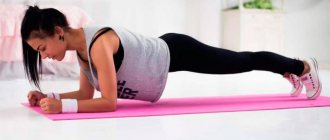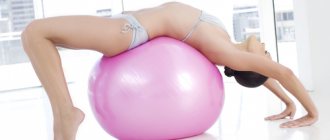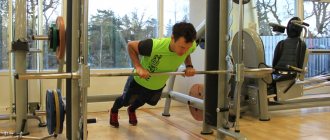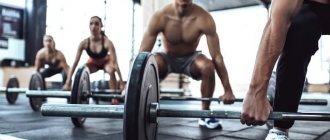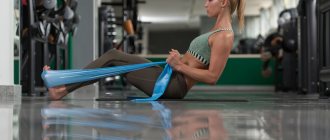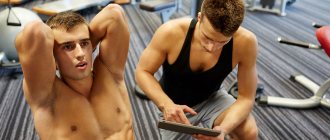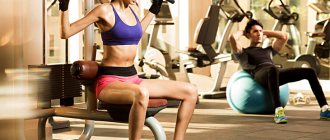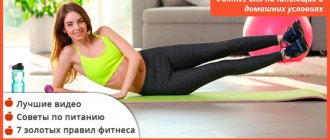Where to start working out in the gym?
You should start working out in the gym by mastering basic exercises that involve several joints and muscle groups.
In order to work the muscle fibers of the whole body, it is necessary to master and perform the following movements:
- Squats.
- Deadlift.
- Bench press from the chest.
- Barbell row to the waist.
- Pull-ups on the bar.
- Army press.
There are also isolating exercises - exercises that involve only one joint. Some of them will be discussed below.
Do I need to buy a subscription?
It is in the best interest of any gym to gain clients on a long-term basis. Therefore, administrators, managers and owners will definitely persuade you to purchase a subscription for long periods - 6 months, a year.
But such a purchase is not always advisable. Tomorrow you find a hall with more suitable conditions, and then what? Not all companies are ready to return your money upon request.
“Experienced” advice: look for an institution with flexible conditions. To get started, buy 4-5 one-time visits to test the equipment, get to know the staff and assess your comfort level. Perhaps your desire to practice here will disappear after the first training session.
If you liked everything unconditionally, it makes sense to purchase a long-term subscription. Its presence is a kind of motivator and stimulant: the money is paid in advance, which means you need to work it off to the fullest.
The cost of a one-time lesson and a subscription depends on the level of the hall and the city in which it is located. The price range is from 150 to 500 rubles per lesson, and from 800 to 3500 rubles. for a month of “unlimited”
Introductory stage of training
The first and most important thing for a beginner is to establish the technique of performing basic exercises and start training.
The first 2 weeks of training should be devoted to practicing basic basic movements:
- Squats.
- Bench press.
- Deadlift.
- Barbell row to the waist.
When developing the movement, it is necessary to use minimal weight, a high number of repetitions and a sufficient number of approaches.
The goal is to accustom the nervous system to perform these movements within the correct technique.
However, the second important factor is stretching, which is necessary to perform the above exercises with “ideal” technique.
Particular attention should be paid to stretching the muscles of the thigh and lower back.
Do you need a trainer?
The question of the need for a coach often faces novice athletes. Many believe that this is a waste of money, since the instructor available in each gym is able to help understand the operation of the simulators and give general recommendations.
And yet the functions of an individual trainer are very important:
- He will help you create a training program.
- Explains the rules for using exercise equipment.
- Monitors the correct technique for performing the elements.
- If necessary, will make adjustments to the program.
Important! It is difficult for beginners to understand how correctly they perform this or that exercise, but the result directly depends on the technique.
Exercise technique
Squats
Squats with a barbell are the main basic exercise that includes all muscle groups of the legs, with the exception of the legs, and a significant part of the muscle mass of the torso - the back muscles.
This exercise has two main styles of execution:
- Classic squats
- Sumo squats
In the first case, the legs are shoulder-width apart, or slightly wider. In the second case, the legs are spaced wide.
Anatomy of movement:
- The starting position is characterized by bringing the shoulder blades together, raising the chest, bending the lower back inward, abducting the pelvis, and slightly tilting the body forward.
- The barbell is located in the area of the trapezius muscles. As a rule, on the axis of attachment of the posterior bundle of the deltoid muscle. Do not place the barbell on your neck.
- The movement begins with the abduction of the pelvis back, accompanied by the mechanics of movement in the knee joints too.
- You should look up or forward, while keeping your back in its original position.
- It is necessary to squat as deeply as the stretch allows, without distorting the position of the back.
- During movement, the knees should go “to the sides”, along the line of the “toes”; it is allowed to spread the knees a little wider. Bringing your knees inward is strictly prohibited.
- When the angle at the knee joint reaches less than 90 degrees, it is necessary to move the pelvis forward, while maintaining the position of the back, raising the chest.
Classic squats load the quadriceps to a greater extent, while sumo squats work evenly all the leg muscles, giving a significant emphasis on the adductors.
This style of execution reduces the range of motion and allows you to take more weight in a one-repetition maximum while reducing the risk of injury to the back, however, it requires more preparation and stretching than the classic version.
You should master both styles of squats, alternating them periodically. This way the legs will receive a full, harmonious load.
Bench press
The bench press is also performed in different styles. Mainly the differences are in grip. Thus, a wide grip emphasizes the chest to a greater extent, while a narrow grip puts the main load on the triceps.
Let's look at the technique of performing the classic bench press that needs to be developed:
- The torso is located on a horizontal bench: The flattened shoulder blades are tightly rested on the bench, the head and buttocks touch the bench, the heels of the feet are firmly on the floor, there is a deflection in the lower back. The position is similar to the position when performing squats. This is the basic position to be in for most exercises.
- The barbell must be taken so that when it touches the chest, a right angle is formed between the brachioradial and humerus bones. The position must be selected empirically in the process of mastering the movement. Standard grip width is 81 cm.
- The entire body should be tightly fixed in the indicated position.
- The bar is removed from the racks
- As you inhale, the movement of lowering the barbell to your chest begins. During which it is necessary to place your elbows not to the sides or along the body, but along a neutral vector.
- The bar does not descend in a straight line down, but along an arc vector, and touches the lower part of the chest in the solar plexus area.
- As you inhale, the barbell is lifted upward in the same arcing motion.
- The rod is fixed in its original position.
Deadlift
There are also several types of deadlifts.
Let's look at the main ones:
- Classic deadlift.
- Sumo style deadlift.
The differences in styles are exactly the same as with squats.
The principle of movement is similar to that used when performing squats:
- The bar is located on the floor.
- A position is assumed in which the shoulder blades are retracted and the lower back is bent, the hands are placed on the barbell at shoulder width, it is necessary to sit down to the barbell while maintaining the correct position of the back.
- Carry out movement, i.e. lifting the barbell is necessary due to the strength of the legs. The chest should be directed upward, you need to look up. The barbell should touch the tibia of the legs during movement.
- The movement is considered complete when the body is vertical and the legs are straightened at the knee joints.
- It is necessary to return the barbell to its original position by controlling its lowering, without throwing it, in order to avoid injury.
Deadlifts and barbell squats are similar exercises because they target the same muscle groups.
Barbell row to the waist
A movement aimed at developing the back muscles.
It also involves the rear deltoids and biceps:
- The position of the body is the same as when performing a deadlift, however, the difference here is that in the initial position the barbell is in the hands. It is necessary to tilt your body forward, slightly bending your knees for convenience, keeping your back in the correct position.
- Using the strength of your back muscles, bringing your shoulder blades together, pull the barbell towards your waist, bringing your elbows as far back as possible.
- As you lower the barbell, fully spread your shoulder blades to achieve maximum muscle stretch.
Program for beginner men
After two weeks of regularly performing four basic movements, as well as doing stretching exercises for guys, the body should have been more or less prepared for the main part of the training program.
Workout No. 1 (Monday)
| Exercises | Approaches x number of times |
| Squats with a barbell on your shoulders | 4 x 6 |
| Romanian deadlift | 4 x 12 |
| Bench Press | 4 x 10 |
| Pull-ups on the bar with weights, or rows of a vertical block | 5 x 10 |
| Shrugs with a barbell | 5 x 15 |
| Ab crunches on the floor | 3 x 20 |
Workout No. 2 (Wednesday)
| Exercises | Approaches x number of times |
| Deadlift | 4 x 6 |
| Front Squats | 4 x 12 |
| Army press | 4 x 12 |
| Barbell row to the waist | 5 x 12 |
| Bent over dumbbell swings | 3 x 15 |
| Crunches on the floor | 3 x 20 |
Workout No. 3 (Friday)
| Exercises | Approaches x number of times |
| Squats | 5 x 8 |
| Bent-overs with a barbell | 4 x 12 |
| Incline Bench Press | 5 x 12 |
| Dips with or without weights | 3 x 15 |
| Pull-ups on the bar behind the head | 4 x 12 |
| Barbell row to the waist | 3 x 8 |
| Shrugs with dumbbells | 4 x 15 |
| Crunches on the floor | 2 x 25 |
What do you need to know?
As you can see, new exercises are being added:
- The Romanian deadlift is a variation of the deadlift on “straight” legs, with a slight bend in the knee joints. Target muscle group: hamstrings.
- Bend overs with a barbell – an exercise similar to squats, without moving the knee joint, develops the hamstrings.
- Military press – Press a barbell while standing on a vertical axis. Strengthens the muscles of the shoulder girdle.
- Pull-ups on the bar train the back, depending on the grip: behind the head - the upper part, wide - the latissimus dorsi, classic and reverse - the middle and the general mass.
- Barbell/dumbbell shrugs are an exercise aimed at strengthening the trapezius muscles of the back. It represents a shrug along the vertical axis. It is forbidden to perform circular rotations with your shoulders.
- The incline bench press is a variation of the bench press that focuses more on the upper pectoral muscles and the anterior deltoids.
- Dips are an exercise that develops the lower pectoral muscles and triceps.
- Front squats are a style of squatting with a barbell aimed at developing the quadriceps and strengthening the spinal stabilizers. By standing the legs wide, it works the adductor muscles. When performing, the barbell is located on the front bundles of the deltoid muscles and is held with your hands. An auxiliary exercise, useful when adjusting the technique of classic squats with a barbell.
- Bent-over dumbbell swings are an isolating exercise aimed at developing the posterior deltoid muscles.
- Hyperextension is an exercise that allows you to strengthen the muscles of the spinal column, performed on a specialized simulator.
- Floor crunches are a classic exercise for the abdominal muscles.
The principles of performing the above exercises are similar to the basic ones given earlier:
- The weight of the weight is selected such that it is possible to perform the specified number of repetitions with a margin of 1-2 repetitions for a total number of up to 6, and with a margin of 2-4 over six repetitions.
- Rest between sets should not be limited. There are many recommendations on this matter on the Internet. The most optimal indicator is your well-being and readiness to perform the next approach. Between approaches you need to rest as much as your body requires. Typically: 1.5 – 5 minutes.
- The rest between workouts lasts, according to the program, one day , however, a longer rest of no more than three days is allowed.
- If muscle pain on the day of the next workout interferes with its implementation , you should reduce the number of approaches to the corresponding muscle group, or add one day of rest.
- After one to three months, it is necessary to change the training program as follows: Alternating heavy and light training weeks. One week is performed with working weights, 70-80% of the maximum weight in the exercise that the athlete can lift for one repetition, the next week 60%, and then the week 90-95%. At the same time, the number of repetitions in exercises per week with a load of 90-95% is significantly reduced to 1-5. “Refusal” can be used no more than once a week.
- Alternate hard and light workouts. One workout is performed with a load of 70-80%, the next with 60%, and the third with 95%.
Program for beginner girls
The training program for beginner women has the following differences from the men's:
- Less stress on the upper body.
- More stress on the lower body.
- Other exercises.
- More reps.
Where should a girl start in the gym?
The better half should begin a set of exercises by mastering the basic exercises given in the introductory stage, while paying great attention to stretching and cardio training.
Workout 1 (Monday)
| Exercises | Approaches x number of times |
| Squats with a barbell on your shoulders | 4 x 12 |
| Bent-overs with a barbell on your shoulders | 3 x 12 |
| Leg curls in the simulator | 2 x 15 |
| Vertical block thrust | 4 x 10 |
| Bench press | 2 x 15 |
| Hyperextension | 2 x 12 |
Workout 2 (Wednesday)
| Exercises | Approaches x number of times |
| Squats with a barbell on your shoulders | 2 x 8 |
| Romanian deadlift | 2 x 12 |
| Leg curls in the simulator | 4 x 15 |
| Barbell calf raises (or in a machine) | 4 x 12 |
| Barbell row to the waist | 2 x 12 |
| Plank | 2 to failure |
| Crunches on the floor | 3 x 20 |
Workout 3 (Friday)
| Exercises | Approaches x number of times |
| Squats with a barbell on your shoulders | 3 x 10 |
| Leg curls in the simulator | 3 x 12 |
| Leg abductions in the simulator, or on the lower block | 4 x 15 |
| Lunges with dumbbells | 3 x 12 |
| Pushups | 3 to failure |
| Vertical block row for the head | 3 x 12 |
| Calf raises with a barbell or in a machine | 2 x 20 |
| Hyperextension | 2 x 12 |
What do you need to know?
- In this women's training program for girls, exercises for the lower body dominate, while the load on the upper body is minimal. Exercises for the upper part are included to harmonize the figure and maintain the tone of the main muscle groups of the upper part - the back and pectoral muscles.
- It is important to perform cardio at the end of each strength training in the same way as described in the men's program, this will significantly prevent the accumulation of excess weight, and will also develop the cardiovascular system of the body.
- A new course of training and exercises is being added: Leg curls in the simulator - an isolating exercise for the hamstrings.
- Barbell calf raises are an exercise for developing the calf muscles. It can be performed in a special simulator.
- The plank is a static exercise aimed at strengthening the spinal stabilizer muscles, performed for a while by holding it in a stable position, standing on your toes and elbows.
- Leg abduction in the simulator is an exercise that works the adductor muscles of the legs.
- Leg abduction in a machine or crossover trains the gluteal muscles. It is necessary to move one leg back, concentrating the tension in the buttock.
- Lunges with dumbbells are an exercise that comprehensively works both the quadriceps and buttocks. Take a step forward and squat in this position, then take the next step with the other leg. Dumbbells are held hanging in the hands.
- Push-ups are an exercise aimed at working the pectoral, deltoid, and triceps muscles. Analogous to the bench press.
Choosing a gym: rocking or fitness
To get a beautiful figure, you will have to work hard on your body. This is where beginners have the question of what to choose – a gym or a fitness club.
An accurate definition of the training goals will help you make the right choice. If an athlete wants to lose weight, tighten body contours, improve his endurance and performance, then he should pay attention to fitness classes. If your main goal is to build muscle mass, then welcome to the gym.
Each of these training locations has its own advantages and disadvantages.
Speaking about fitness, it is worth mentioning its advantages such as:
- accessibility (basic elements can be performed by almost anyone);
- versatility (group classes are suitable for most athletes);
- variety of programs (from strength training to express weight loss).
It is also worth mentioning that when training in a group, it is much more difficult to miss an appointment without a good reason.
Important! Speaking about the disadvantages, first of all it is worth mentioning the cost of the subscription. The second disadvantage is the tight schedule. The athlete will have to adapt to the majority. Another fly in the ointment is the limited enrollment in groups. You may not have time to sign up for the program you like.
People most often go to the gym to gain bulky muscles. Additionally, the cardiovascular system and endurance are strengthened. With a well-developed training plan, working out in the gym, you can lose weight.
The main advantages of the hall are:
- a variety of exercise machines that can load almost all muscle groups;
- weight of additional sports equipment;
- convenient visiting schedule;
- lower cost of a subscription compared to a fitness club;
- individual lesson plan with the possibility of its subsequent adjustment;
- clearer focus on results.
There are some downsides here too:
- lack of experience in using equipment and exercise equipment for beginners (first lessons only with a coach or instructor);
- "full house" in the evening after work.
Each athlete chooses where and how to exercise, but beginner athletes should still consult with experts.
Programs to increase working weight
In “natural” training, i.e. without the use of pharmacological drugs, the redistribution of muscle mass depends on the strength of the osseous-ligamentous apparatus. The thicker and stronger the ligaments, the more muscle mass the body will allow itself to build.
The strength of the ligaments depends on the need for it, i.e. depending on how large the training weight is.
High-threshold fast muscle fibers, which are trained exclusively by strength training, in the repetition range from 1 to 5 with heavy weights, are responsible for the implementation of muscle contraction in a short period of time with maximum effort.
Let's look at several training programs that will help increase working weight in basic exercises.
Program for increasing working weight in the bench press
To increase the working weight in the bench press, you need to perform this movement in every workout, the same goes for all other exercises. At the same time, the specifics of performing the bench press will be radically different.
Let's consider in detail:
| Exercises | Approaches x number of times |
| Bench press | 5 x 8 |
| Bench press | 10 x 15 |
| Bench press | 3 x 3 |
| Bench press | 2 x 12 |
| Bench press | 3 x 6 |
| Bench press | 4 x 15 |
| Bench press with pause | 5 x 5 |
| Bench press | 4 x 15 |
| Bench press | 2 x 2 |
| Bench press with pause | 3x10 |
| Bench press | 4 x 12 |
| Bench press | 4 x 2 |
| Bench press | 4 x 15 |
| Bench press | 4 x 20 |
In this case, microperiodization is used, which has a beneficial effect on the development of the nervous system and an increase in strength indicators in this exercise. The numbers indicate the workouts themselves, which are performed after 1-3 days; they can be combined with training for other muscle groups.
Program for increasing working weight in deadlift
Deadlifts and squats with a barbell are similar exercises, so programs for increasing working weight in these movements will be similar:
| Exercises | Approaches x number of times |
| Deadlift | 3 x 12 |
| Squats | 4 x 6 |
| Deadlift from the pit 40% of maximum | 4 x 10 |
| Deadlift 60% of maximum | 5 x 12 |
| Deadlift from plates 100% of maximum | 3 x 6 |
| Barbell squats 60% | 4 x 10 |
| Deadlift 80% | 5 x 5 |
| Deadlift from the pit 30% | 10 x 10 |
| Deadlift 85% | 3 x 5 |
| Barbell squats 75% | 4 x 8 |
| Deadlift from the pit 40% | 10 x 10 |
| Deadlift penetration | Up to 1 rep with maximum weight |
Program for increasing working weight in squats
| Exercises | Approaches x number of times |
| Squats | 3 x 12 |
| Deadlift | 4 x 6 |
| Paused barbell squats with a weight of 40% of the maximum | 5 x 10 bent over barbell 3 x 12 |
| Front Squats | 3 x 10 Romanian deadlift 3 x 10 |
| Squats | 3 x 3 |
| Deadlift | 5 x 15 |
| Squats | 2 x 15 |
| Deadlift from plates | 3 x 3 |
| Squats | 4 x 8 |
| Front Squats | 5 x 3 Romanian deadlift 3 x 8 |
| Squats | 2 x 12, pit deadlift 2 x 10 |
| Squats | 6 x 6 |
| Deadlift | 6 x 6 |
| Paused barbell squats | 4 x 8 (40%) |
| Paused barbell squats | 1 x 10 (30%) |
| Squat walk | up to 1 repetition with maximum weight |
- The program should include training once every two weeks with a weight of 95% of the maximum and above.
- It is necessary to include light training to develop movement and train the central nervous system.
- It is necessary to add “auxiliary” exercises, such as “bench press with pause”, “squats with pause”, “deadlift from the pit”, “bench press from a bar (pressure)”, “half squat”, “deadlift from the block » – to overcome “dead zones” when driving.
- All approaches are not performed to failure. When performing an exercise, you should leave 1-2 repetitions in reserve in the case of training for a low number of repetitions, and about 5 repetitions when training for a high number of repetitions. This will help avoid central nervous system fatigue.
How to Choose the Right Weight and Number of Reps
Take such a weight that you can perform the exercise 5-8 times. The last repetitions should be performed with effort. If you can easily do all eight reps, then the selected weight is too light for you.
Perform three sets of 5–10 reps. Rest between sets should be 1-2 minutes, between exercises - 2-3 minutes.
If you are doing exercises without weights, you will need to do more repetitions to properly engage the muscles. For these exercises, perform three sets of 20 repetitions.
Programs for the mass of individual muscle groups
Let's look at simple training schemes for the development of specific muscle groups, which can be combined with each other either by working out the whole body in a workout or by a split program, or added to an existing training plan.
Abs training program
Workout 1:
| Exercises | Approaches x number of times |
| Crunches on a vertical block (“prayer”) | 4 x 8 |
| Hanging leg raises on bars/bars | 4 x 15 |
| Crunches on the floor | 2 sets to failure |
Workout 2:
| Exercises | Approaches x number of times |
| Crunches on the floor | 3 x 20 |
| Hanging leg raises to the sides (for oblique muscles) | 2 x 15 |
| Twisting on a vertical block (“prayer”) with body turns (on the oblique muscles) | 4 x 12 |
Workout 3:
| Exercises | Approaches x number of times |
| Crunches on a vertical block (“prayer”) | 3 x 10 |
| Twisting on a vertical block (“prayer”) with body turns | 3 x 10 |
| Leg raises while hanging straight and with body turns (on the oblique muscles) alternately | 3 x 15 |
| Plank | 2 sets for maximum time |
Shoulder training program
Workout 1:
| Exercises | Approaches x number of times |
| Army press | 3 x 8 |
| Swings with dumbbells | 2 x 12 |
| Bent over dumbbell swings | 2 x 12 |
| Pull a horizontal block to the chin | 2 x 15 |
Workout 2:
| Exercises | Approaches x number of times |
| Swings with dumbbells | 3 x 15 |
| Bent over dumbbell swings | 2 x 15 |
| Barbell row to the chin | 2 x 15 |
Workout 3:
| Exercises | Approaches x number of times |
| Bench press | 2 x 6, 2 x 10 |
| Pull a horizontal block to the chin | 4 x 12 |
| Swings with dumbbells | 2 x 8 |
Chest muscle training program
Workout 1:
| Exercises | Approaches x number of times |
| Bench press | 3 x 6 |
| Incline Dumbbell Flyes | 3 x 8 |
| Bringing the hand on the lower block | 2 x 12 |
Workout 2:
| Exercises | Approaches x number of times |
| Dips with weights | 4 x 12 |
| Push-ups with feet elevated | 2 to failure |
| Dumbbell flyes on a horizontal bench | 2 x 15 |
Workout 3:
| Exercises | Approaches x number of times |
| Incline Barbell Press | 3 x 10 |
| Pushups | 2 to failure |
| Bringing the hand on the lower block | 2 x 15 |
Leg training program
Workout 1:
| Exercises | Approaches x number of times |
| Squats | 4 x 8 |
| Romanian deadlift | 2 x 12 |
| Barbell calf raises | 4 x 16 |
Workout 2:
| Exercises | Approaches x number of times |
| Deadlift | 2 x 10 |
| Front Squats | 4 x 12 |
| Barbell calf raises | 3 x 8 |
Workout 3:
| Exercises | Approaches x number of times |
| Barbell squats 60% of maximum weight | 5 x 8 |
| High jump | 3 x 10 |
| Single leg calf raises with kettlebell | 3 x 12 |
| Superset of leg bending/extension in the simulator | 3 x 25 |
Workout 4:
| Exercises | Approaches x number of times |
| Squats | 5 x 5 |
| Bent-overs with a barbell | 3 x 12 |
| Barbell calf raises | 2 x 10 |
Workout 5:
| Exercises | Approaches x number of times |
| Deadlift from the pit | 4 x 12 |
| Barbell squats 40% of max weight | 6 x 8 |
Trapezius training program
Workout 1:
| Exercises | Approaches x number of times |
| Shrugs with a barbell | 4 x 12 |
| Army press | 3 x 10 |
| Shrugs with dumbbells | 3 x 20 |
| Lee Haney Deadlift | 3 x 15 |
Workout 2:
| Exercises | Approaches x number of times |
| Seated overhead press | 3 x 6 |
| Bent-over dumbbell shrugs | 3 x 12 |
| Bent-over barbell row with a pause at the top point | 3 x 10 |
| Vertical block row for the head | 3 x 15 |
Workout 3:
| Exercises | Approaches x number of times |
| Army press | 2 x 15 |
| Shrugs with a barbell | 3 x 10 |
| Bent-over dumbbell shrugs | 4 x 15 |
Butt training program
Workout 1:
| Exercises | Approaches x number of times |
| Squats | 4 x 12 |
| Romanian deadlift | 3 x 8 |
| Leg abductions in the simulator | 3 x 15 |
Workout 2:
| Exercises | Approaches x number of times |
| Deadlift | 3 x 8 |
| Lunges with a barbell | 4 x 12 |
| Bent-overs with a barbell | 3 x 10 |
| Barbell squats 60% with pause | 3 x 6 |
Workout 3:
| Exercises | Approaches x number of times |
| Squats | 3 x 6 |
| Pelvic adduction from a lying position with weights | 4 x 12 |
| Romanian deadlift | 3 x 10 |
| Leg abductions in the simulator | 3 x 15 |
Triceps training program
Workout 1:
| Exercises | Approaches x number of times |
| Close grip bench press | 3 x 8 |
| Dips | 3 x 12 |
| Arm extensions on a vertical block | 4 x 15 |
Workout 2:
| Exercises | Approaches x number of times |
| French press | 4 x 15 |
| Close grip push-ups | 3 x 15 |
| Bent over arm extension with dumbbell | 3 x 15 |
Workout 3:
| Exercises | Approaches x number of times |
| Close grip bench press | 2 x 6 |
| Arm extensions on a vertical block | 3 x 12 |
| Close grip push-ups | 2 to failure |
Biceps training program
Workout 1:
| Exercises | Approaches x number of times |
| Bent-over barbell row | 4 x 6 |
| Barbell curl | 3 x 10 |
| Hammers | 4 x 12 |
Workout 2:
| Exercises | Approaches x number of times |
| Pull-ups on the bar | 3 x 12 |
| Hammers | 4 x 15 |
| Crossover curls | 3 x 10 |
Latissimus dorsi training program
Workout 1:
| Exercises | Approaches x number of times |
| Wide grip pull-ups | 4 x 6 |
| Horizontal block thrust | 3 x 12 |
| Bent-over dumbbell row with one hand | 2 x 15 |
Workout 2:
| Exercises | Approaches x number of times |
| Bent-over barbell row | 5 x 12 |
| Wide Grip Vertical Row | 5 x 15 |
Workout 3:
| Exercises | Approaches x number of times |
| Bent-over T-bar row | 2 x 10 |
| Bent-over row in the lower block | 4 x 15 |
| Classic pull-ups on the bar | 2 sets to failure |
What kind of simulators
One of the advantages of the gym is the simulators that make it easier to perform elements or correct technique.
Stanislav Lindover
European champion, master of sports in bodybuilding
Beginning athletes need to train on machines with a given trajectory of movement,” says Stanislav. In this case, the correct technique for performing the elements is guaranteed.
The power frame is a system of vertical posts and horizontal crossbars. On it you can comfortably perform bench press (when using a bench), deadlift, squat with a barbell and pull-ups.
A horizontal bar is a multifunctional sports equipment designed for performing various types of pull-ups.
A leg press machine is a system that includes a seat, supports for canopies and a moving platform. Allows you to pump up your leg muscles.
The Scott Bench is a prefabricated metal frame with a bench and an adjustable desk. Helps work your biceps.
Vertical-horizontal traction is a system of blocks that can be worked both in a sitting and standing position. Allows you to train your upper back.
Crossover is a multifunctional block exercise machine designed for combined upper and lower training.
General programs for gaining muscle mass
There are many “typing” programs, the most effective ones are listed below.
The best program for gaining muscle mass
Let's consider the ideal training program for gaining muscle mass.
Workout 1:
| Exercises | Approaches x number of times |
| Bench press | 4 x 3 |
| Squats | 5 x 5 |
| Bent-overs with a barbell | 2 x 8 |
| Weighted pull-ups | 5 x 5 |
| Army press | 3 x 8 |
Workout 2 (the very next day):
| Exercises | Approaches x number of times |
| Squats with a barbell with a pause of 40% of the maximum weight | 4 x 8 |
| Close grip bench press | 3 x 10 |
| Barbell row to the waist | 2 x 12 |
| Crunches on the floor | 3 x 20 |
| Hyperextension | 3 x 12 |
| Standing calf raises | 4 x 12 |
Workout 3 (every other day):
| Exercises | Approaches x number of times |
| Deadlift | 3 x 8 |
| Bench press | 3 x 8 |
| Front Squats | 2 x 10 |
| Vertical block thrust | 4 x 12 |
| Bent over dumbbell swings | 3 x 12 |
Workout 4 (the next day):
| Exercises | Approaches x number of times |
| Leg extensions in the exercise machine (pumping style) | 3 sets in the middle of the amplitude of 40 seconds of slow movement with a rest of 20 seconds between sets |
| Crunches on the floor | 2 x 15 |
| Standing calf raises | 4 x 10 |
Workout 5 (every other day):
| Exercises | Approaches x number of times |
| Bench press | 4 x 12 |
| Squats with a barbell on your shoulders | 4 x 8 |
| Army press | 2 x 10 |
| Pull-ups | 4 x 8 |
| Superset: Dumbbell swings x12 + shrugs x15 | 4 approaches |
Workout 6 (the very next day):
| Exercises | Approaches x number of times |
| Pause squats 50% of maximum weight | 4 x 10 |
| Standing block row with emphasis on the rear delts | 4 x 12 |
| Abdominal training on a pulley (pulley) | 3 x 12 |
| Plank | 2 to failure |
Antagonist muscle training program
There is such a split scheme option as training antagonist muscles. It consists of training opposite muscles in one day.
For example:
- Monday: deltoids, arms (biceps/triceps/brachialis/forearm muscles)
- Wednesday: Legs (quadriceps/hamstrings/glutes/adductors/calves)
- Friday: chest, back.
In this case, for natural training, this option will be effective for the arms and deltas, since these muscle groups will be included in the work both on Monday and Friday, with basic exercises for the back and pectoral muscles, but the remaining muscle groups will grow highly doubtful.
Let's create a split program as follows:
Monday:
| Exercises | Approaches x number of times |
| Bench press | 4 x 6 |
| Army press | 4 x 8 |
| Incline Dumbbell Flyes | 3 x 12 |
| Barbell row to the waist | 4 x 8 |
| Pull-ups | 4 x 12 |
| Shrugs | 4 x 15 |
| Swings with dumbbells | 3 x 12 |
Tuesday:
| Exercises | Approaches x number of times |
| Squats | 5 x 5 |
| Romanian deadlift | 4 x 10 |
| Front Squats | 4 x 12 |
| Standing calf raises | 4 x 12 |
Thursday:
| Exercises | Approaches x number of times |
| Incline Bench Press | 4 x 12 |
| Close grip bench press | 4 x 8 |
| Vertical block row for the head | 4 x 10 |
| Wide grip pull-ups | 4 x 8 |
| Bent over dumbbell swings | 3 x 12 |
| Shrugs | 4 x 10 |
Friday:
| Exercises | Approaches x number of times |
| Deadlift | 4 x 8 |
| Lunges | 3 x 12 |
| Pause squats with a weight of 50% of maximum | 4 x 8 |
| Superset of leg bending/extension in the simulator | 3 x 15 |
| Calf raises | 4 x 12 |
Massive program for experienced athletes
- Actually, there are no differences in terms of gaining muscle mass and pumping, however, in terms of increasing strength indicators, there are differences.
- Having reached the genetic limit, it is very difficult to “break through” strength indicators, however, it is possible.
- The first method, the use of anabolic steroids, should not be considered, since their use is permissible only in professional sports.
- But the second method is used by both “natural” athletes and “professionals”, this is macroperiodization.
- The bottom line is that we significantly reduce working weights by performing a series of light workouts over several months, gradually approaching the previous strength indicators.
During such “detraining,” the body becomes disadapted to the training process, which causes it to experience habitual, past stress as potentially strong and new, which leads to a corresponding response in the form of a gain in muscle mass and an increase in strength indicators.
- Week 1 – daily training according to the program from the introductory stage.
- Week 2 – similar, but with a weight of 40% of the maximum.
- Week 3 – weight 50% of the maximum, training every other day.
- Week 4 – weight 60% of the maximum, the number of repetitions is reduced by 2.
- Week 5 – 70% weight, the number of repetitions is reduced by 1 sets per 1.
- Week 6 – 80% of the maximum, the number of repetitions is reduced by 2 sets per 1.
- Week 7 – 85%, the number of repetitions is reduced to 4, sets to 3, squats and deadlifts alternate.
- Week 8 – 90% of the maximum, the number of repetitions is reduced to 3, sets to 2.
- Week 9 – 92.5% – same intensity.
- Week 10 is an easy week, similar to week 6, two workouts per week.
- Week 11 – 95% – 2 reps, 2 sets, two workouts per week.
- Week 12 is an easy week similar to week 6, three workouts per week.
- Week 13 – 97.5% – 2 reps, 4 sets – one workout per week, two workouts similar to week 4.
- Week 14 – similar to week 5.
- Week 15 – 100% of previous maximum reps 3, sets 2.
Further, it becomes clear that the previous weights are much easier, provided that the volume of training is small. You should move forward very slowly, adding minimal weight.
There can be many options for macroperiodization. This program is designed to increase strength indicators, which will lead to growth of muscle mass. Similar training schemes are used in powerlifting.
You can dilute the training program with pumping exercises and cardio training. It is allowed to count not from the maximum weight, but from the working weight.
Mass program: impact on muscle growth factors
Training:
- Pumping training with light weights is carried out the next day after classical strength training, or on the same day after it.
- Once every two weeks, it is necessary to perform heavy strength approaches in the bench press, squats and deadlifts for 1-3 repetitions with a weight of 90-100% of the maximum.
- Only pumping approaches are performed to failure.
- The frequency of training should be at least once every four days. It is most advisable to train the entire body during a workout using almost only basic exercises.
Other:
- Sleep at least 8 hours a day.
- Adequate nutrition: 1.5 g of protein, 3.5-4 g of carbohydrates, 0.6-1 g of fat per 1 kg of body weight. Fortification
- Minimizing bad habits.
- Reducing stress levels in everyday life
The main factor is high testosterone levels, which are maintained by getting enough sleep and consuming enough saturated fatty acids.
Regular exercise also stimulates testosterone secretion. Alcohol and nicotine reduce testosterone levels, while caffeine blocks its synthesis for a period of about six hours.
Nervous experiences and stress stimulate the release of stress hormones such as cortisol, adrenaline, norepinephrine, which are testosterone antagonists. Excessive levels of stress force the body to expend its own energy resources beyond measure, which leads to exhaustion and overwork of the nervous system, which also affects testosterone levels.
Common mistakes made by newbies
Let's look at the main mistakes that gym goers who do not have the proper experience most often make and tips on how to correct the situation:
- Trying to lift too much weight without mastering the technique of the exercise. This mistake is the most serious because it can lead to severe injuries. Working weights should be increased gradually, having first fully mastered the technique of performing the exercises.
- Neglecting basic exercises in favor of isolating exercises. This error is visible in every gym. Young guys often grab dumbbells when performing biceps curls, mistakenly believing that this will lead to increased muscle mass in their arms. However, this can only lead to a waste of time. The muscle mass of both the arms and the whole body will increase along with the increase in strength indicators in basic exercises for large muscle masses.
- Working out a muscle group less than once every four days. When training without the use of anabolic steroids, muscle growth zones are open for two days after strength training, therefore regular stimulation of muscle fibers is necessary, preferably every other day, and ideally every day. To avoid overtraining with this training regimen, it is necessary to train low volume and low intensity, inserting heavy training once or twice a week.
- Short rest between sets. If you follow common recommendations and rest only 40 seconds between sets, this will lead to excess accumulation of lactic acid, which will destroy muscle tissue. A short rest is only advisable in case of pumping when training slow muscle fibers. During standard strength training, rest should be from 1.5 to 5 minutes, depending on the working weight, the number of repetitions and the characteristics of the body.
- Inadequate nutrition and sleep. Very often, gym goers are “undernourished,” which prevents them from effectively gaining muscle mass, although they feel like they are consuming a lot of food. For accuracy, it is advisable to count the consumed amount of proteins, fats and carbohydrates, then the reason for stopping muscle mass gain will most likely become clear.
Useful nuances
If you are serious about results, start keeping a training diary from your first workout. Numbers never lie: with them you will know exactly whether there is progress, whether it is worth increasing the load, how many approaches you do and how much time you devote to classes.
Full recovery after exercise is a whole science. You will need energy-dense, high-calorie foods, preferably with a minimum amount of fat. A chocolate milkshake or special bars for athletes are suitable.
During classes, try to disconnect from everyday and professional problems and fully focus on physical sensations. Believe me, the exercises themselves perfectly relieve tension and form the right emotional tone.
It is better to turn off your phone completely during the training (unless, of course, you are expecting an important call). And if you are talking with someone, do it outside the room: nothing disrupts the mood more than extraneous conversations.
And the last piece of advice: do not use perfume or deodorant with a strong smell before training. Sweat plus perfume is not the most pleasant combination.
Bottom line
The desire for quick results often leads to disappointment at best, and injury at worst. To achieve your goal, you must be willing to work hard day after day, systematizing and analyzing your training process, regimen and lifestyle.
Patience and regular weight training, while following the principles outlined in the article, will over time lead to a gain of high-quality and functional muscle mass.

Alexandrova Anastasia
Nutrition and healthy lifestyle specialist and author of myfitnesblog.com. For many years, she has successfully helped women and men lose weight and maintain a beautiful figure.
Warm-up
If you exercise without warming up, you greatly increase the risk of injury and reduce the effectiveness of your workout.
In addition, this is how you form the wrong habits. Warm-up is a mandatory element of training. You can easily get your muscles into working condition by following a simple procedure:
- Use a massage roller . Such rollers help to thoroughly warm up the muscles of the whole body. Here Lifehacker explained in detail what these tools are and how to use them.
- Do cardio for five minutes : walk uphill at a brisk pace, exercise on an elliptical trainer or exercise bike. If you are overweight, you should not run - take care of your knees.
- Be sure to do joint warm-up and dynamic stretching . Here you will find a video of a good warm-up.
After this, you will be warmed up enough to begin the lesson.
